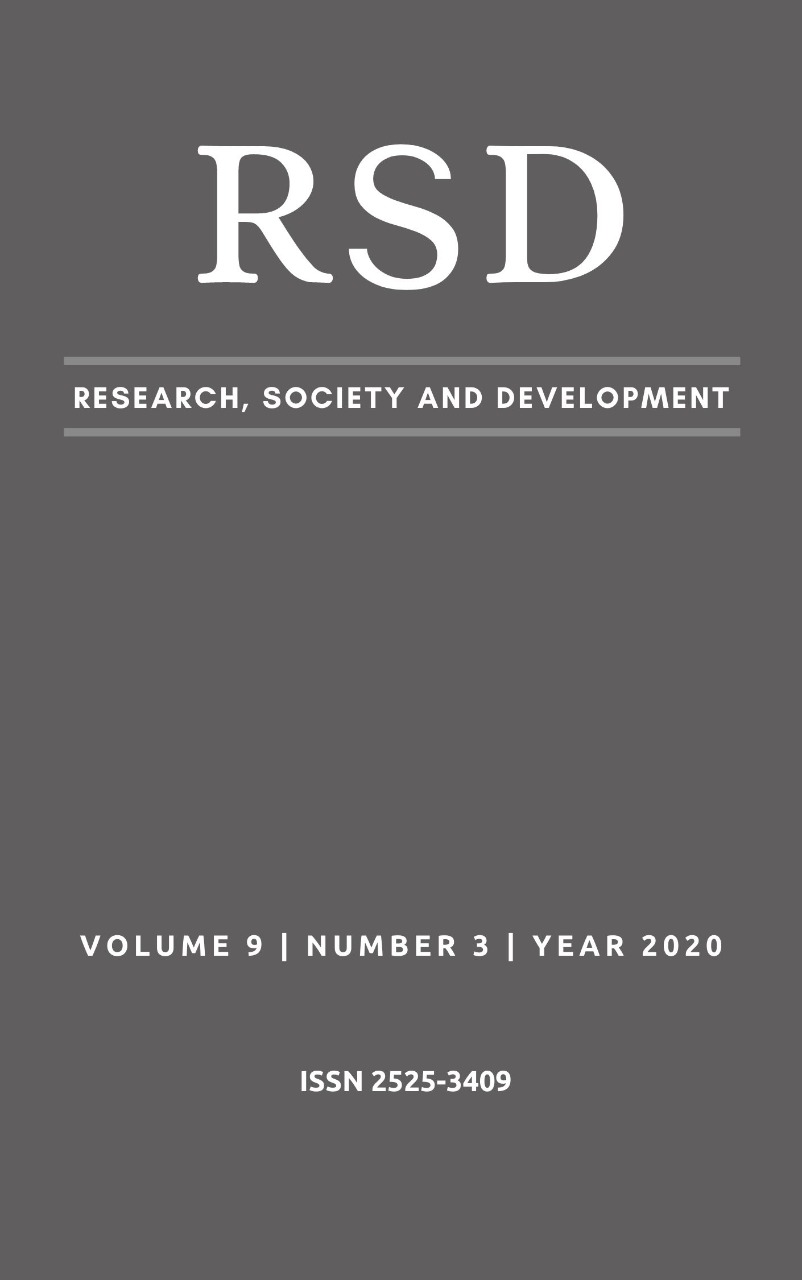Diagnóstico dos danos ambientais, riscos e perigos presentes no lixão de Massaranduba – PB
DOI:
https://doi.org/10.33448/rsd-v9i3.2442Palavras-chave:
Resíduos sólidos; Lixão de Massaranduba; Riscos e perigos.Resumo
A disposição final dos resíduos sólidos produzidos diariamente tornou-se um empecilho, sendo fonte geradora de diversos impactos ambientais, favorecendo a degradação ambiental. Para minimizar esses efeitos, existem alguns métodos de disposição final como: lixões; aterros sanitários (controlado e sanitário); compostagem e reciclagem. Porém o mais utilizado na região Nordeste são os lixões, todavia, este método e o mais agressivo ao meio ambiente. Nesse contexto, é necessário realizar uma análise preliminar de riscos e o Checklist com o intuito de prever o quanto os resíduos podem prejudicar o solo, a água e o ar de determinada localidade, determinando assim seus riscos e perigos. Esta pesquisa foi baseada na avaliação dos danos ambientais diagnosticados por meio do conhecimento dos riscos e perigos apresentados no gerenciamento dos resíduos sólidos urbanos e no lixão. Inicialmente foi elaborado um questionário para ser aplicado aos garis e catadores responsáveis pela coleta seletiva do lixão e da cooperativa de reciclagem do referido município. Após a primeira etapa, foram quantificados os dados acerca dos riscos e perigos desses materiais. Os resultados obtidos por meio das respostas dos questionários comprovaram que os garis e coletores não usam todos os equipamentos de proteção individual, sendo expostos a riscos e perigos eventuais do trabalho. A quantificação do nível de risco médio foi crítico e a magnitude do perigo foi média, valores preocupantes, porém possíveis de serem revertidos.
Referências
Alencar, M. C. B.; Cardoso, C. C. O; Antunes, M. C. (2009). Condições de trabalho e sintomas relacionados à saúde de catadores de recicláveis em Curitiba. Revista de Terapia Ocupacional da Universidade de São Paulo, 20(1), 36-42. DOI: https://doi.org/10.11606/issn.2238-6149.v20i1p36-42
Bellezoni, R. A.; Iwai, C. K.; Elis, V. R.; Paganini, W. D. S.; Hamada, J. (2014). Small-scale landfills: impacts on groundwater and soil. Environmental. Earth Sciences, 71, 2429-2439. DOI: 10.1007/s12665-013-2643-1
Brasil. (2010). Lei nº. 12.305: estabelece a Política Nacional de Resíduos Sólidos.
Brasil. (2014). Ministério do Trabalho e Emprego. NR6: Equipamentos de proteção individual. São Paulo: Manual de Legislação Atlas.
Faria, M. T. (2011). Gerência de riscos: apostila do curso de especialização em engenharia de segurança do trabalho. Paraná: Universidade Tecnologica do Paraná.
França, S. L. B; Toze, M. A; Quelhas, O. L. G. (2008). A gestão de pessoas como contribuição à implantação da gestão de riscos. O caso da indústria da construção civil. Revista Produção, 8(4), 1-19. DOI: https://doi.org/10.14488/1676-1901.v8i4.142
Gabriel, D. A; Ferreira, R. M; Colcerniani, B. D. L; André, M; Camejo, D. A; Soares, A. L. (2015). Riscos Ocupacionais em Atividade de Coleta de Resíduos Sólidos. Engineering and Science, 3(1), 3-17. DOI: http://dx.doi.org/10.18607/ES201532549
Guerreo, L. A.; Maas, G.; Hogland, W. (2013). Desafios da gestão de resíduos sólidos para cidades de países em desenvolvimento. Gerenciamento de resíduos, 33(1), 220-232.
Hoornweg, D.; Bhada-Tata, P. (2012). What a waste: a global review of solid waste management. Urban development series. Washington: World Bank. URI: http://hdl.handle.net/10986/17388
Maciel, R. H.; Matos, T. G. R.; Borsoi, I. C. F.; Mendes, A. B. C. Siebra P. T.; Mota, C. A. (2011). Precariedade no trabalho e nas condições de vida de catadores de materiais recicláveis de Fortaleza, CE. Arquivos Brasileiros de Endocrinologia e Metabologia, 63, 71-82.
Mahmood, K.; Batool, S. A.; Chaudhery, M. N. (2016). Studying bio-thermal effects at and around MSW dumps using satellite remote sensing and GIS. Waste Management. 55, 118-128. DOI: 10.1016/j.wasman.2016.04.020.
Oliveira, T. B; Galvão, J. A. C. (2018). Planejamento municipal na gestão dos resíduos sólidos urbanos e na organização da coleta seletiva. Revista de Engenharia Sanitária e Ambiental, 21(1), 55-64. DOI: 10.1590/S1413-41520201600100155929
Vaverková, M. D.; Maxianová, A.; Winkler, J.; Adamcová, D.; Podlasek, A. (2019). Environmental consequences and the role of illegal waste dumps and their impact on land degradation. Land Use Policy, 89, 104-234. DOI: https://doi.org/10.1016/j.landusepol.2019.104234
Yan, W. Y.; Mahendrarajah, P.; Shaker, A.; Faisal, K.; Luong, R.; Al-Ahmad, M. (2014). Analysis of multi-temporal Landsat satellite images for monitoring land surface temperature of municipal solid waste disposal sites. Environmental Monitoring and Assessment, 186 (12), 1861-1873. DOI: https://doi.org/10.1007/s10661-014-3995-z
Ziraba, A. K.; Haregu, T. N.; Mberu, B. (2016). A review and framework for understanding the potential impact of poor solid waste management on health in developing countries. Archives of Public Heath, 74(55), 1-11. DOI: 10.1186/s13690-016-0166-4
Texeira, K. M. D. (2015). Trabalho e perspectivas na percepção dos catadores de materiais recicláveis. Psychology in Society, 27(1), 98-105. DOI: http://dx.doi.org/10.1590/1807-03102015v27n1p098.
Downloads
Publicado
Como Citar
Edição
Seção
Licença
Autores que publicam nesta revista concordam com os seguintes termos:
1) Autores mantém os direitos autorais e concedem à revista o direito de primeira publicação, com o trabalho simultaneamente licenciado sob a Licença Creative Commons Attribution que permite o compartilhamento do trabalho com reconhecimento da autoria e publicação inicial nesta revista.
2) Autores têm autorização para assumir contratos adicionais separadamente, para distribuição não-exclusiva da versão do trabalho publicada nesta revista (ex.: publicar em repositório institucional ou como capítulo de livro), com reconhecimento de autoria e publicação inicial nesta revista.
3) Autores têm permissão e são estimulados a publicar e distribuir seu trabalho online (ex.: em repositórios institucionais ou na sua página pessoal) a qualquer ponto antes ou durante o processo editorial, já que isso pode gerar alterações produtivas, bem como aumentar o impacto e a citação do trabalho publicado.

